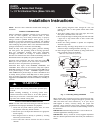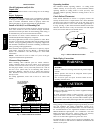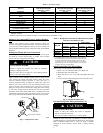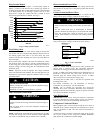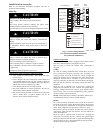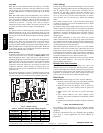
2
INSTALLATION
Check Equipment and Job Site
Unpack Unit
Move to final location. Remove carton taking care not to damage
unit.
Inspect Equipment
File claim with shipping company prior to installation if s hipment
is damaged or incomplete. Locate unit rating plate on unit corner
panel. It contains information needed to properly install unit.
Check rating plate to be sure unit matches job specifications.
Install on a Solid, Level Mounting Pad
If conditions or local codes require the unit be attached to pad, tie
down bolts should be used and fastened through knockouts
provided in unit base pan. Refer to unit mounting pattern in Fig. 2
to determine base pan size and knockout hole location.
For hurricane tie downs, contact distributor for details and PE
Certification (Professional Engineer), if required.
On rooftop applications, mount on level platform or frame. Place
unit above a load--bearing wall and isolate unit and tubing set from
structure. Arrange supporting members to adequately support unit
and minimize transmission of vibration to building. Consult local
codes governing rooftop applications.
Roof mounted units exposed to winds above 5 mph may require
wind baffles. Consult the Service Manual -- Residential Split
System Air Conditioners and Heat Pumps for wind baffle
construction.
NOTE: Unit must be level to within ±2° (±3/8 in./ft) per
compressor manufacturer specifications.
Clearance Requirements
When installing, allow sufficient space for airflow clearance,
wiring, refrigerant piping, and service. Allow 24 in. (609.6 mm)
clearance to service end of unit and 48 in. (1219.2 mm) (above
unit. For proper airflow, a 6--in. (152.4 mm) clearance on 1 side of
unit and 12--in. (304.8 mm) on all remaining sides must be
maintained. Maintain a distance of 24 in. (609.6 mm) between
units. Position so water, snow , or ice from roof or eaves cannot fall
directly on unit.
On rooftop applications, locate unit at least 6 in. above roof
surface.
3/8---in. (9.53 mm) Dia.
Tiedown Knockouts in
Basepan(2) Places
View From Top
UNIT BASE PAN
Dimension
TIEDOWN KNOCKOUT LOCATIONS in. (mm)
A B C
26 X 26 9–1/8 (231.8) 4–7/16 (112.7) 21–1/4 (539.8)
31–1/2 X 31–1/2 9–1/8 (231.8) 6–9/16 (166.7) 24–11/16 (627.1)
35 X 35 9–1/8 (231.8) 6–9/16 (166.7) 28–7/16 (722.3)
A05177
Fig. 2 -- Tiedown Knockout Locations
Operating Ambient
The minimum outdoor operating ambient in cooling mode
without accessory is 55°F (12.78°C), and the maximum outdoor
operating ambient in cooling mode is 125°F (51.67°C). The
maximum outdoor operating ambient in heating mode is 66 °F
(18.89°C).
Check Defrost Thermostat
Check defrost thermostat to ensure it is properly l ocated and
securely attached. There is a liquid header with a brass distributor
and feeder tube going into outdoor coil. At the end of the one of
the feeder tubes, there is a 3/8 in. O.D. stub tube approximately 2
in. long. (See Fig. 3.) The defrost thermostat should be located on
stub tube. Note that there is only one stub tube used with liquid
header, and on most units it is the bottom circuit.
FEEDER TUBE
DEFROST
THERMOSTAT
STUB TUBE
A97517
Fig. 3 -- Defrost Thermostat Location
Make Piping Connections
!
WARNING
PERSONAL INJURY AND ENVIRONMENTAL
HAZARD
Failure to follow this warning could result in personal injury
or death.
Relieve pressure and recover all refrigerant before system
repair or final unit disposal.
Use all service ports and open all flow--control devices,
including solenoid valves.
CAUTION
!
UNIT DAMAGE HAZARD
Failure to follow this caution may result in equipment damage
or improper operation.
If ANY refrigerant tubing is buried, provide a 6--in (152.4
mm). vertical rise at service valve. Refrigerant tubing lengths
up to 36--in (914.4 mm). may be buried without further special
consideration. Do not bury lines longer than 36 in (914.4 mm).
Outdoor units may be connected to indoor section using accessory
tubing package or field --supplied refrigerant grade tubing of correct
size and condition. For tubing requirements beyond 80 ft,
substantial capacity and performance losses can occur . Following
the recommendations in the Application Guideline and Service
Manual--Residential Split--System Air Conditioners and Heat
Pumps will reduce these losses. Refer to Table 1 for accessory
requirements. Refer to Table 2 for field tubing diameters.
There are no buried--line applications greater than 36 in.
If refrigerant tubes or indoor coil are exposed to atmosphere, they
must be evacuated to 500 microns to eliminate contamination and
moisture in the system.
25HCS



